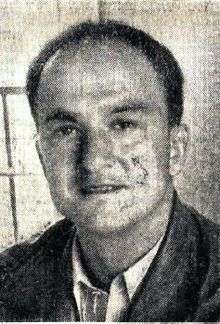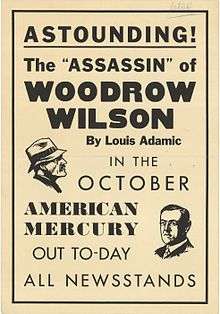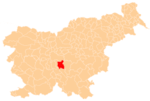Louis Adamic
| Louis Adamic | |
|---|---|
 | |
| Born |
Alojz Adamič 23 March 1898 Praproče pri Grosupljem, Austro-Hungarian Empire (present-day Slovenia) |
| Died |
4 September 1951 (aged 53) Milford, New Jersey, United States |
| Nationality | Yugoslav |
| Occupation | Author, translator |
| Awards | Anisfield-Wolf Book Award for From Many Lands |
Louis Adamic[notes 1] (Slovene: Alojz Adamič) (23 March 1898[notes 2] – 4 September 1951) was a Slovene-American author and translator, mostly known for writing about and advocating for ethnic diversity of America.[4]
Life
Alojz Adamič was born at Praproče Mansion in Praproče pri Grosupljem in the region of Lower Carniola, in what is now Slovenia (then part of the Austro-Hungarian Empire). The oldest son of a peasant family, he was given a limited childhood education at the city school and, in 1909, entered the primary school at Ljubljana. Early in his third year he joined a secret students' political club associated with the Yugoslav Nationalistic Movement that had recently sprung up in the South-Slavic provinces of Austria-Hungary.
Swept up in a bloody demonstration in November 1913, Adamic was briefly jailed, expelled from school, and barred from any government educational institution. He was admitted to the Jesuit school in Ljubljana, but was unable to bring himself to go. "No more school for me. I was going to America," Adamic wrote. "I did not know how, but I knew that I would go."[5]
On 31 December 1913, at the age of 15, Adamič emigrated to the United States.[6]
He finally settled in a heavily ethnic Croatian fishing community of San Pedro, California. He became a naturalized United States citizen in 1918 as Louis Adamic. He worked as a manual laborer and later at a Yugoslavian daily newspaper, Narodni Glas ("The Voice of the Nation"), that was published in New York. As an American soldier he participated in combat on the Western front during the First World War. After the war he worked as a journalist and professional writer.
Work

All of Adamic's writings are based on his labor experiences in America and his former life in Slovenia. He achieved national acclaim in America in 1934 with his book The Native's Return, which was a bestseller directed against King Alexander's regime in the Kingdom of Yugoslavia. This book gave many Americans their first real knowledge of the Balkans. It contained many insights, but proved far from infallible: Adamic predicted that America would prosper by eventually "going left", i.e. turning socialist.
He received the Guggenheim Fellowship award in 1932. During the Second World War he had supported the Yugoslav National liberation struggle and the establishment of a socialist Yugoslav federation. He founded the United Committee of South-Slavic Americans in support of Marshal Tito. From 1949 he was a corresponding member of the Slovenian Academy of Sciences and Arts.
From 1940 onwards he served as editor of the magazine Common Ground. Adamic was the author of Dynamite: The Story of Class Violence in America (1931); Laughing in the Jungle: The Autobiography of an Immigrant in America (1932); The Native's Return: An American Immigrant Visits Yugoslavia and Discovers His Old Country (1934); Grandsons: A Story of American Lives (1935, novel); Cradle of Life: The Story of One Man's Beginnings (1936, novel); The House in Antigua (1937, travel); My America (1938); From Many Lands (1940); Two-Way Passage (1941); What's Your Name? (1942); My Native Land (1943); Nation of Nations (1945); and The Eagle and the Root (1950). Maxim Lieber was his literary agent, 1930–1931 and in 1946. In 1941, Adamic won the Anisfield-Wolf Book Award for From Many Lands.
Adamic was strongly opposed to the foreign policy followed by British Prime Minister Winston Churchill, and in 1946 wrote Dinner at the White House which purported to be an account of a dinner party given by President Franklin D. Roosevelt at which Adamic and Churchill had both been present. After the proofs had been passed by publishers Harper and Brothers, an additional footnote was inserted in pages 151 and 152 which claimed that Churchill had opposed the National Liberation Front in Greece because they intended to scale down the rate of interest Greece was paying to Hambros Bank. The footnote further claimed that Hambros had "bailed Winston Churchill out of bankruptcy in 1912".
The footnote appeared in the book when it was published, and a copy was circulated to every British Member of Parliament; when Churchill was alerted, he instructed his solicitors to issue a writ for libel. Harper and Brothers admitted the statement was untrue and Adamic also withdrew the claim and apologised; a substantial sum of damages was paid,[7] reported by the Daily Express as £5,000.[8] As of 2011 the copy of Dinner at the White House in the British Library is held in the 'Suppressed Safe' collection, inaccessible to readers.[9]
Plagued by failing health, he is believed to have shot himself at his residence in Milford, New Jersey. He died at a time of political tension and intrigue in Yugoslavia, and there was press speculation in America that his death might have been an assassination by some Balkan faction, but no definitive proof of this theory has ever surfaced.
According to John McAleer's Edgar Award-winning Rex Stout: A Biography (1977), it was the influence of Adamic that led Rex Stout to make his fictional detective Nero Wolfe a native of Montenegro, in what was then Yugoslavia.[10] Stout and Adamic were friends and frequent political allies, and Stout expressed uncertainty to McAleer about the circumstances of Adamic's death. In any case, the demise seems to have inspired Stout's 1954 novel The Black Mountain, in which Nero Wolfe returns to his homeland to hunt down the killers of an old friend.
Sources
- Elizabeth Bentley FBI deposition, 30 November 1945, FBI file 65-14603.
- FBI Silvermaster file (PDF format pgs. 38,39, 52,53) pgs. 437, 438, 451, 452 in original.
- "Home Again From America," Harper's Magazine, October 1932.
Notes
- ↑ Adamic told The Literary Digest: "My name is pronounced in this country (i.e. America) exactly as the word Adamic, pertaining to Adam": a-dam'ik.[1] His original surname was Adamič, pronounced in Slovenian a-DAH-mich.
- ↑ The year 1899 is often cited and is also written on Adamic's tombstone, but is incorrect. It was written in Adamič's certificate of origin by the mayor in Grosuplje in 1913, in order to enable Adamic to leave Austro-Hungarian Empire, which did not allow 15-year-old boys to leave the country, because they were to enter the army.[2] The correct year is written in the register of births of the Parish of Žalna.[3]
External links
| Wikimedia Commons has media related to Louis Adamič. |
- Twelve Harper's Magazine articles by Louis Adamic, written between 1930 and 1943 (only for subscribers)
- Immigration History Research Center at the University of Minnesota (Louis Adamic papers)
- Find-a-Grave memorial for Louis Adamic
- Louis Adamič Primary School, named after Louis Adamic, in Grosuplje, Slovenia
References
- ↑ Funk, C. E. (1936) What's the Name, Please?: A guide to the correct pronunciation of current prominent names, Funk & Wagnalls Company, Digitized 12 February 2010
- ↑ "Slavistična revija". 30. Slavistično društvo v Ljubljani, Inštitut za slovenski jezik, Inštitut za literaturo, 1982: 352.
- ↑ Adamič, France (1983). Spomini in pričevanja o življenju in delu Louisa Adamiča [Memories and Testimonies about the Life and Work of Louis Adamic] (in Slovenian). Ljubljana: Prešernova družba [Prešeren's Society]. p. 19. COBISS 14064129.
- ↑ Shiffman, D. (2003) Rooting Multiculturalism: The Work of Louis Adamic, Fairleigh Dickinson University Press, ISBN 9780838640029
- ↑ Adamic, Louis. Laughing in the Jungle: The Autobiography of an Immigrant in America. New York and London: Harper & Brothers, 1932. Reprinted by Arno Press and The New York Times, 1969; pp. 10–35.
- ↑ In his author's note to his autobiography, Laughing in the Jungle (1932), Adamic describes himself as being "a boy of fourteen and a half" in 1913, when he left his native country for America (p. ix). "Late in the afternoon of the last day of 1913 I was examined for entry into the United States, with about a hundred other immigrants who had come on the Niagara (p. 43).
- ↑ "Mr. Churchill gets damages and apology", The Manchester Guardian, 16 January 1947, p. 3.
- ↑ "Libel on Churchill – damages £5,000", Daily Express, 16 January 1947, p. 3.
- ↑ "The SS [Suppressed Safe] Collection of the British Library". Scissors & Paste Bibliographies. Retrieved 12 October 2011.
- ↑ For more information see the origins section of the article on Nero Wolfe.
